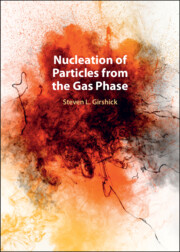Book contents
- Nucleation of Particles from the Gas Phase
- Reviews
- Nucleation of Particles from the Gas Phase
- Copyright page
- Dedication
- Contents
- Preface
- Symbols
- 1 Introduction
- 2 Single-Component Homogeneous Nucleation from a Supersaturated Vapor
- 3 Classical Nucleation Theory
- 4 Classical Theory of Multicomponent Nucleation
- 5 Classical Theory of Ion-Induced Nucleation
- 6 Atomistic Approaches to Homogeneous Nucleation
- 7 Transient Nucleation
- 8 Chemical Nucleation
- 9 Nucleation in Plasmas
- References
- Index
6 - Atomistic Approaches to Homogeneous Nucleation
Published online by Cambridge University Press: 30 May 2024
- Nucleation of Particles from the Gas Phase
- Reviews
- Nucleation of Particles from the Gas Phase
- Copyright page
- Dedication
- Contents
- Preface
- Symbols
- 1 Introduction
- 2 Single-Component Homogeneous Nucleation from a Supersaturated Vapor
- 3 Classical Nucleation Theory
- 4 Classical Theory of Multicomponent Nucleation
- 5 Classical Theory of Ion-Induced Nucleation
- 6 Atomistic Approaches to Homogeneous Nucleation
- 7 Transient Nucleation
- 8 Chemical Nucleation
- 9 Nucleation in Plasmas
- References
- Index
Summary
In single-component homogeneous nucleation, the summation expression for the steady-state nucleation rate requires values of the forward rate constants and Gibbs free energies of cluster formation. If atomistic data are available for these quantities, then these could be used instead of CNT. In an atomistic approach, clusters are treated as distinct molecular species, rather than as a small piece of the bulk condensed phase. Examples are presented of atomistic data generated by means of computational chemistry for water clusters up to size 10, and for aluminum clusters up to size 60. In both cases, the free energy of cluster formation is found to be a multimodal function of cluster size, both quantitatively and qualitatively different than in CNT. Condensation rate constants can be affected by the need for a third body as a collision partner, and by attractive intermolecular forces in collisions between clusters and monomers. An approach is suggested for constructing a “master table” of free energies of cluster formation, based on a hybrid of atomistic data, experimental values inferred by means of the nucleation theorem, and extrapolations to larger cluster sizes based on CNT.
Keywords
- Type
- Chapter
- Information
- Nucleation of Particles from the Gas Phase , pp. 122 - 144Publisher: Cambridge University PressPrint publication year: 2024

